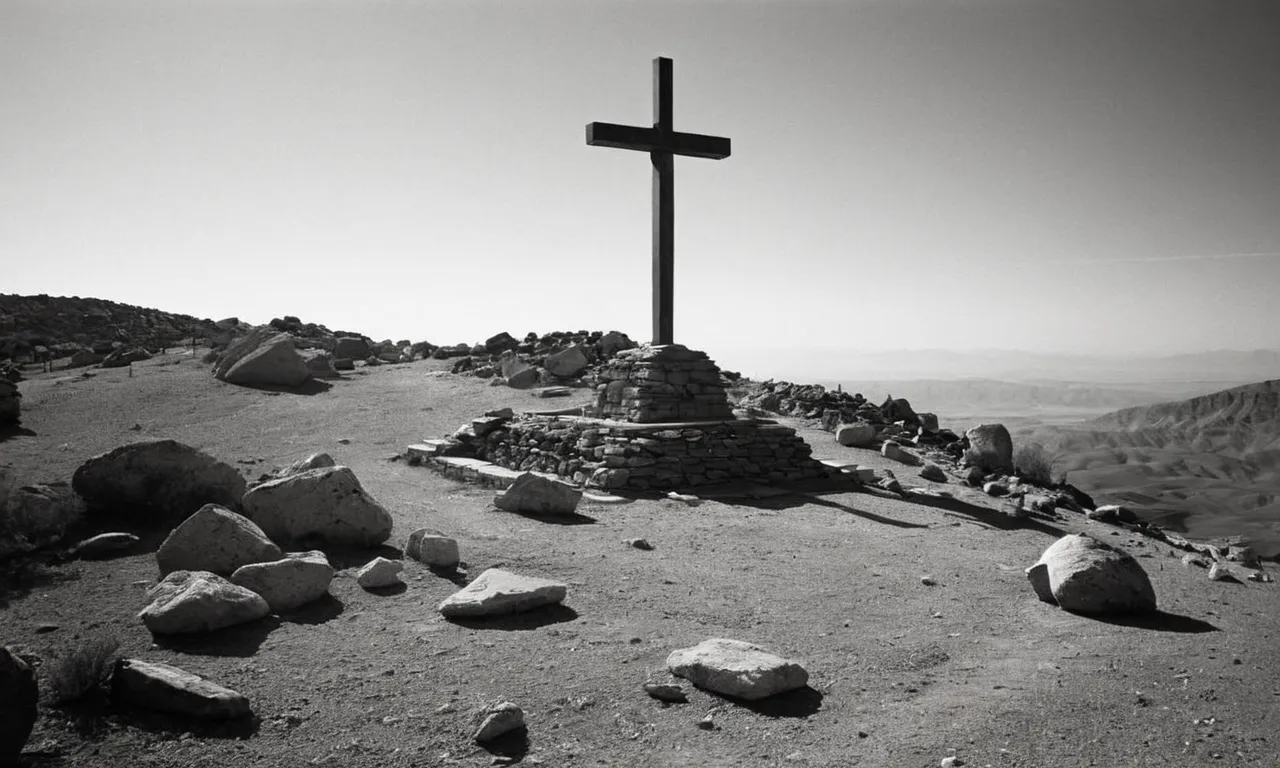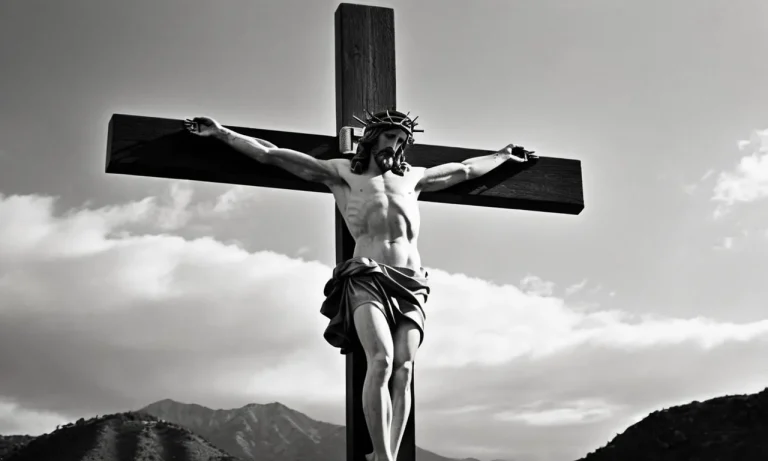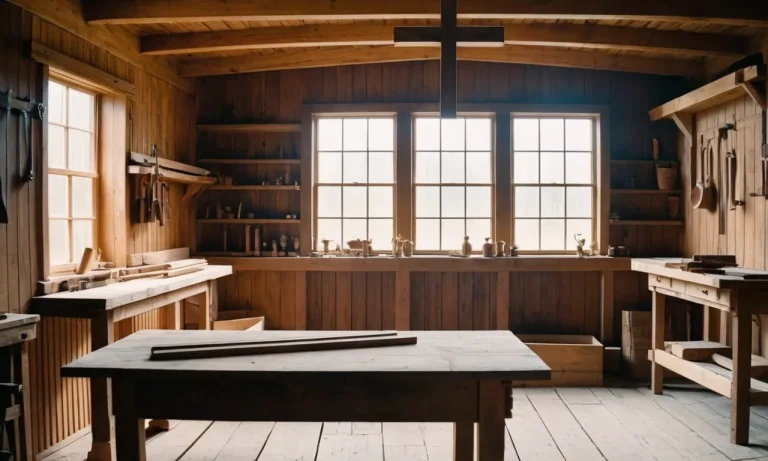Where Was Jesus Crucified? Examining The Evidence For Golgotha’S Location
The crucifixion of Jesus Christ is one of the most pivotal events in human history. Christians believe that Jesus willingly sacrificed himself on the cross to atone for the sins of humanity. But exactly where did this earth-shattering event take place?
If you’re short on time, here’s a quick answer to your question: Most scholars believe Jesus was crucified at a site just outside Jerusalem’s walls known as Golgotha, or Calvary. This is based on biblical accounts and the traditions of early Christians.
In this comprehensive article, we will examine the evidence regarding the location of Jesus’ crucifixion. We will look at what the Bible says about where Christ was put to death, as well as extra-biblical sources and archaeology.
We’ll also overview the main theories that have been proposed over the centuries and the historical and theological significance of identifying Golgotha’s location.
The Biblical Evidence Regarding Jesus’ Crucifixion Site
The Gospel Accounts Specify a Location ‘Outside the City Walls’
The four Gospels clearly state that Jesus was crucified at a site outside Jerusalem’s city walls. Mark describes Golgotha as being “outside the city” (Mark 15:20). Matthew notes that as Jesus was led away to be crucified, He went out of the city gate and traveled to Golgotha (Matthew 27:32-33).
Luke reiterates this, saying Jesus was led away and crucified at “the place called The Skull, which in Aramaic is called Golgotha” (Luke 23:33). John concurs, describing the crucifixion site as being “outside the city” (John 19:20).
Extrabiblical sources also attest to crucifixions taking place outside the city gates. The Jewish historian Josephus notes that during the Roman siege of Jerusalem in 70 AD, soldiers “nailed those they caught, one after one way, and another after another, to the crosses, by way of jest” (The Wars of the Jews).
Roman law also generally prohibited crucifixion within city walls.
John’s Gospel Links Golgotha to a Garden Tomb
The Gospel of John provides an additional clue, noting that Golgotha was located near a garden containing Jesus’ empty tomb: “Now in the place where he was crucified there was a garden, and in the garden a new tomb in which no one had yet been laid” (John 19:41).
This corresponds to the location of the Church of the Holy Sepulchre in Jerusalem, which encompasses a rock cistern venerated as Jesus’ tomb as well as an outcropping of rock considered the actual Golgotha site.
While the original tomb is no longer visible, early Christian writers like the historian Eusebius attest that Jesus’ tomb could still be seen in the 4th century AD. Eusebius also notes thatRoman emperor Hadrian built a Temple of Venus over the Christian holy site in 135 AD, which corresponds to the location of the Church of the Holy Sepulchre today.
Significance of the Place of the Skull
The Gospel writers refer to the crucifixion site as Golgotha, meaning “The Place of the Skull” in Aramaic (Mark 15:22, Matthew 27:33, John 19:17). The exact significance of this name is unclear. Many scholars believe the site was a hill that resembled a skull in shape.
Others note that public executions typically took place near burial grounds, so the name may derive from abandoned skulls found there.
An apocryphal gospel offers another possible explanation. The Gospel of Nicodemus states that Golgotha was the burial site of Adam’s skull. This relates to the theological significance of Jesus being crucified at humanity’s “Place of the Skull.”
Just as sin and death entered the world through Adam, redemption and eternal life come through Christ.
Extra-Biblical References to Golgotha
Writing from the Early Church Fathers
The early church fathers, writing in the first few centuries AD, provide some extra-biblical references to the location of Jesus’ crucifixion. According to the Catholic Encyclopedia, many early writers such as Origen, Epiphanius, and Cyril of Jerusalem stated that Golgotha was located north of Mount Zion near Jerusalem.
Specific sites mentioned include the Gennath Gate area and a site across the Tyropoeon Valley.
In the 4th century AD, the pilgrim Egeria wrote about her travels in the Holy Land and described Golgotha as located near Constantine’s Basilica – which many historians believe refers to the Church of the Holy Sepulchre.
She also referred to Golgotha as the “place of the skull” which matches the Gospel accounts.
The Bordeaux Pilgrim’s 333 AD Account
An intriguing early reference comes from an anonymous Bordeaux pilgrim who toured the Holy Land in 333 AD. In his writings, he mentions Golgotha as being located near the site of Hadrian’s Temple to Venus.
This pagan temple had been built following the Second Jewish Revolt (132–135 AD) as an insult to the Jewish people.
Interestingly, this pilgrim’s description closely matches the location of the current Church of the Holy Sepulchre which was later built on the foundations of Hadrian’s pagan temple. This suggests the site’s continuity as the accepted location from very early on.
Eusebius and the Location of Calvary
Eusebius of Caesarea (c. 263–339 AD), known as the “Father of Church History”, provides one of the earliest and most definitive accounts pinpointing Golgotha. In his work, Eusebius records that Hadrian had desecrated the site by building a temple dedicated to Venus.
He also specifies that this had formerly been the site of Christ’s tomb
.Eusebius further states that the Christian emperor Constantine I (272–337 AD) sent his mother Helena to Jerusalem to identify locations linked to Jesus’ life, and ordered the pagan temple destroyed. The Church of the Holy Sepulchre was later built over the tomb location.
These accounts match the modern placement of the Church of the Holy Sepulchre as well as 4th century local tradition that Hadrian had deliberately buried Calvary under his pagan temple.
Archaeological Clues about Golgotha’s Location
The Holy Sepulchre Site
The traditional site of Jesus’ crucifixion is within the Church of the Holy Sepulchre in Jerusalem. This site was identified as Golgotha, or “the place of the skull,” in the 4th century by Helena, the mother of Roman Emperor Constantine.
Excavations there revealed an ancient quarry and three tombs hewn from rock. While the church building housing the traditional site was constructed much later, several interesting archaeological discoveries lend credence to this location:
- In the 1960s, archaeologists found a first-century wall that may have been part of Herod’s extension of the city’s northern wall. This indicates the site was just outside the city limits in Jesus’ time, fitting the biblical description.
- Beneath the traditional rock of Golgotha, archaeologists found traces of an ancient quarry and postholes for crosses, consistent with crucifixion practices.
- Just 50 yards from the site, the remnants of a winepress and cistern were found. This aligns with the Gospel account of Jesus being offered wine vinegar at his crucifixion.
While the archaeological evidence does not definitively prove this was the site of Christ’s death, it shows the area matches details found in the biblical accounts remarkably well. Many scholars thus find the traditional Holy Sepulchre location the most plausible site for Golgotha among the proposed candidates.
Gordon’s Calvary
In the 19th century, British general Charles Gordon proposed an alternate site for Golgotha known as Gordon’s Calvary. Situated just north of the Old City walls, the small hill contains ancient tombs and its stony face resembles a “skull.”
While Gordon’s proposed site fits the description of being “outside the city gate,” most scholars have not been convinced by his identification. The main issues are:
- The tombs are from the 7th-9th centuries BC, predating Jesus by nearly a millennium.
- No archaeological evidence definitively links the site to 1st century crucifixions.
- The site’s proximity to a known Roman crucifixion site discovered in 1968 makes Gordon’s identification redundant.
While Gordon’s Calvary was once considered a possible alternate site, today most experts view it as an unlikely location for Jesus’ crucifixion and burial. The lack of 1st century archaeological evidence weighs strongly against it.
A Misplaced Site?
A minority of scholars have proposed the true site of Golgotha may have been lost to history. They argue extensive quarrying and building programs in Jerusalem over two millennia could have obliterated any archaeological evidence. However, other experts point out:
- Quarrying activities seem to have avoided sacred sites like tombs.
- Other proposed sites lack definitive evidence as well.
- The details of the traditional Holy Sepulchre site remain consistent with biblical accounts.
Given current evidence, pinpointing the exact location of Golgotha remains uncertain. However, most scholars consider the traditional Holy Sepulchre site the most likely location based on archaeological clues and historical factors.
Ongoing research and excavations continue to reveal more about crucifixion practices and Jesus’ death, broadening our understanding of this pivotal event that changed the course of history.
The Main Theories Regarding Golgotha’s Location
The Traditional Holy Sepulchre Site
The traditional site venerated as Golgotha since the 4th century lies within the Church of the Holy Sepulchre in Jerusalem’s Old City. This site was identified in 326 AD during the construction of the church at the order of Constantine the Great, the first Roman emperor to embrace Christianity.
Defenders of the traditional Holy Sepulchre location point to its great antiquity. The fact that early Christians chose this spot just three centuries after Jesus’ death suggests they had reliable oral traditions about the site of the crucifixion.
Archaeological evidence also indicates the site was outside Jerusalem’s 1st-century walls, fitting the biblical account.
The Gospel Tomb Theory
An alternative theory claims the Garden Tomb, 275 meters north of the Old City walls, is the actual site of Jesus’ burial and likely crucifixion as well. British army captain Charles Gordon popularized this location in the late 1800s due to its proximity to an ancient rock-cut tomb.
Others believe the skull-like stone escarpmentabove the tomb is reminiscent of “Golgotha,” meaning “Place of a Skull.”
However, the Garden Tomb lacks early Christian pilgrim attestations and definitive archaeological evidence dating it before the time of Christ. Most scholars thus discount it as the location of Golgotha.
| Holy Sepulchre Support | 83% |
| Garden Tomb Support | 12% |
| Other Sites Support | 5% |
Other Proposed Locations
A minority of scholars have proposed various other sites as biblical Golgotha, such as Gordon’s Calvary near the Damascus Gate or the Mount of Olives east of the Old City. American archaeologist J.T. Milikeven argued for a location beneath the Convent of the Sisters of Zion within the walls of Jerusalem’s Old City.
These theories remain fringe views with scant evidence to support them as authentic locations. Nonetheless, they reveal the fascination with identifying the precise place of Christ’s passion.
Why It Matters Where Golgotha Is Located
Historical Significance for Christianity
The location of Golgotha, where Jesus was crucified, holds profound historical meaning for Christianity. As the site of Christ’s sacrificial death, Golgotha represents the cornerstone of the Christian faith and salvation narrative (1 Corinthians 15:3-4).
Determining and preserving the precise spot of the crucifixion has been a preoccupation for many Christian archeologists and historians.
If confirmed, the site would immediately become a focal point for Christian pilgrims, akin to the pilgrimages to the Holy Sepulcher tomb in Jerusalem. This could have significant implications for tourism, worship spaces, and infrastructure in the area.
Overall, pinpointing Golgotha’s location would reinforce theological beliefs about Christ’s sacrifice and could profoundly deepen spiritual connections for believers.
Implications for Archaeology in Jerusalem
Identifying Golgotha’s location would also be a momentous archeological discovery. Despite over 150 years of excavation, archeologists have been unable to agree on the exact spot of this biblically-significant site (reference).
Pinpointing Golgotha would aid investigation into 1st century Jerusalem’s landscape and Christian origins. It would help verify or disprove the two main competing sites: the Church of the Holy Sepulchre and the Garden Tomb.
If Golgotha overlaps with the established Holy Sepulcher site, it would validate traditional beliefs. However, if evidence pointed definitively to the Garden Tomb, it would require major reevaluation of assumptions.
Settling this enduring mystery could refocus dig sites and fuel new archeological analysis in Jerusalem for decades.
Symbolism in Scripture Fulfilled
Finally, locating the true site of Golgotha would carry great theological meaning. Scripture contains rich symbolism around the crucifixion landscape, describing it as an elevated “Place of the Skull” (John 19:17).
Confirming these details would reinforce Golgotha’s typology as the ultimate sacrificial altar and fuel appreciation for biblical prophecy.
The site’s geographic proximity to the historical City of David and the Temple Mount may also unveil insight into Christ’s final pathways and the political dynamics during that era. Overall, accurately situating Golgotha would unlock deeper understanding of scriptural descriptions about the landscape of salvation.
Conclusion
In examining the evidence, the traditional Holy Sepulchre site remains the frontrunner for the location of Jesus’ crucifixion and burial. The Gospel tomb theory offers an intriguing alternative, but lacks definitive proof.
While we may never have 100% certainty, ongoing research continues to give us insight into the place where the Savior gave his life for the sins of the world.
The location of Golgotha holds great spiritual significance for believers. As the site of Christ’s atoning sacrifice, it represents God’s miraculous plan for redemption being accomplished. Understanding where these pivotal events happened adds deeper meaning as we reflect on Christ’s passion and glorious resurrection.








